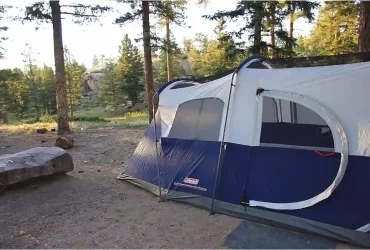The canvas tent is not just an outdoor shelter—it is home away from home, a basecamp for your outdoor adventures. With Airdrie Canvas, you will always get dependable advice and a friendly demeanor when it comes to working with canvas. One of the questions they regularly receive is “Can you paint canvas tents? ”
The short answer is yes, canvas tents can be painted. Paints such as acrylic are recommended, and each coat should be allowed to dry before applying the next one. Painting canvas involves a little more than this simple explanation.
What Kind of Paint Do you Use on Canvas Fabric?

Canvas fabric should be painted with the right paint type to ensure not only its beauty but also its durability. A tent’s longevity and functionality will be affected by the paint type, so it’s important to know how it affects them. Here are some tips for choosing canvas tent paint: acrylic, latex, spray paint, and fabric dye.
Acrylic vs. Latex
Due to canvas’ flexibility and durability, acrylic or latex paint is often used to paint tents. Their quick drying time and water-based nature make them easy to use and clean.
Acrylic paint works best on canvas because it’s flexible and does not crack easily. Due to its resistance to weather changes, it is ideal for use in various outdoor conditions. It’s also available in a wide variety of colors, so you can express yourself freely.
Canvas tents can also be painted with latex paint, which is commonly used to paint houses. Fabric may require thinning since it is usually thicker. The material adheres well and is fairly durable, although it is less flexible than acrylic, so it may crack over time.
Spray Paint
The advantage of spray paint is that it is easy to apply. In addition, it covers large areas quickly and evenly without brushing or rolling. Additionally, the fabric spray paint is specially designed to prevent cracks and peels and keep the fabric flexible.
Spray paint is airborne, so it requires a well-ventilated environment and protective gear such as masks and gloves. In addition, it is less precise than brush-on paints, which is why intricate designs won’t work well with it.
Dye
Canvas tents can easily be transformed with fabric dye solutions instead of traditional paint methods. Dyeing provides a degree of permanence and resilience that is impossible to achieve via painting alone. Dye penetrates fibers in textiles to produce a long-lasting, wash-resistant color change. It gives the fabric a beautifully organic aesthetic because the dye maintains the fabric’s texture.
Canvas can be dyed in three different ways: spray, dip, or brush. Despite its bright, vibrant colors, canvas tents complement the rugged nature of canvas tents beautifully. Dyes are used to create stunning, durable, and weather-resistant canvas tents that stand out on any campsite. Camping is not just about colors – dyes demonstrate the robust and adventurous spirit of the camper.
Also like this:
Techniques for applying paint

The choice you make here will greatly affect your tent’s ease of application and aesthetics. Below will be discussed three common painting methods: brushing, spraying, and roller-brushing.
Brush
Canvas tents are best painted with brushes, which provide the greatest level of control over your application. Brushes are available in various sizes and types, so you can choose the one that works best for you.
A brush is used to apply the paint or dye to ensure thorough penetration, ensuring durability. It may be necessary to paint larger tents more than once to achieve an even finish. Those who enjoy the journey as much as the destination find the brushwork process therapeutic and rewarding.
Spray Gun
Paint can be applied evenly to large areas of canvas quickly and quickly using a spray gun or paint sprayer. With tents that are larger or to apply base coats, this method can save a great deal of time and energy. It would be impossible to achieve a smooth and consistent finish by brushing or rolling paint in a fine mist.
The use of spray guns does require preparation and skills, including masking off areas you don’t want painted and providing adequate ventilation. Overspray is easily carried by the wind, so protective gear is also necessary. Because of its efficiency and smooth finish, spray guns are very popular paint tools for canvas tents despite these disadvantages.
Roller Brush
Combining a roller brush can result in the best of both worlds when painting a canvas tent. With rolling, large areas are covered efficiently and evenly, while with brushing, corners and seams can be reached.
However, it provides a level of control that can be difficult with spraying alone, despite requiring more effort. The roller applies paint evenly, while the brush adds fine details with fewer visible strokes. It is possible to achieve a professional finish with a little practice by combining these two methods.
How to Paint a Canvas Tent: Step-by-Step

Painting a canvas tent not only adds creativity to the process, but it also extends the tent’s lifespan and functionality. Step-by-step instructions for painting, preparing, and finishing your canvas tent are included.
Setting up and cleaning up
- It is best to set up your tent in an open area that is clean, so that you will have plenty of room to move around it. As a result, you will have access to all parts of the tent that need to be painted.
- Brushing the canvas gently with a soft brush is the best way to clean it. Creating a mild cleaning solution using warm water and mild detergent is a good solution for stubborn dirt. Softly scrub the surface with a soft brush after thoroughly cleaning with clean water. When cleaning canvas, avoid harsh cleaners or bleach because they can damage it.
- Prior to painting the tent, you should allow it to completely dry. This process may be delayed for several days or even a few hours depending on the weather. Paint must be applied only after the canvas is completely dry.
- Ensure your tent is properly set up after cleaning and repairing any damage. Before beginning to paint, make sure the canvas is free of holes or tears.
Design and Paint Selection
- Acrylic, latex, spray paint, or dye can all be used depending on your preferences and the look you want to achieve. There are advantages and disadvantages to each, as we discussed earlier.
- Choose the colors that you want. Consider how your design will appear on the canvas if you are using more than one color.
- Be sure to test a small, inconspicuous area of the tent before you start painting to ensure that the paint will adhere well and give you the effect you desire.
Masking and protecting tents
- Painter’s tape can be used to seal off areas where your design shouldn’t extend, such as zippers, windows, or parts of the canvas. Additionally, the tape can be used to outline a design, which is especially useful for geometric patterns and lines.
- Ensure your work area is protected from paint spills and splatters with drop cloths or plastic sheeting. It is important to ensure that your surroundings are sufficiently protected and well ventilated when working indoors.
Tent Painting
- If you choose to paint your tent or dye it, you should start painting or dying it. Whether you are painting with a brush, spray gun, or both, you should take your time. Rushing can lead to errors and uneven application of the product.
- Several coats may be necessary to achieve desired color intensity. Allow each coat to dry completely before applying the next.
The Curing and Drying Process
- It is important to make sure your tent is completely dry before using it. This process could take anywhere between several hours and a few days depending on the paint type and weather conditions. Prevent any paint smudging by ensuring that your tent has dried completely before packing it away.
- Immediately following the paint drying, the tent must be cured. Hardening occurs here, and the paint adheres to the canvas completely. Depending on the type of paint, it may take a few days to a few weeks to dry. It is advisable not to pack your tent up or expose it to harsh weather during this time.
Also like this:
Sealing (Optional)
- Choose a sealant that is suitable for outdoor use, and that is compatible with the paint or dye you intend to use.
- Sealant should be applied according to the manufacturer’s directions, which usually require spraying or brushing.
- It is important to let the sealant dry completely before packing up your tent.
Voila! You have now built yourself a beautiful canvas tent, ready for the next camping trip. With this project, you can give an old tent a new lease on life and express your creativity and style at the same time.
FAQ’s
Is it better to paint your canvas tent rather than dye it?
Paint is fast, extremely efficient, and when done correctly, there are fewer variables than dying, which might or might not succeed. A painting can be enhanced by adding a pattern or stencil, as well as allowing greater control over the outcome.
Canvas is debated on both sides about whether it fades as quickly when painted correctly as when dyed. Although dyeing experts might find it strange, it is worth considering.
Is it possible to paint my canvas tent using other methods?
Definitely. It is possible to get an excellent painting result with spray paint even if you do not use a brush, roller, or even dip, although you are not required to do so.
Can I spray paint my canvas tent instead of using a paint can?
Yes, absolutely! These spray guns are professional tools, and they take some time and caution to use, especially when mixing paint and thinning agents. Using these tools correctly can enable canvas tents to be painted.
What is the shelf life of acrylic paint on canvas?
Properly cared for acrylic paint has a life expectancy of decades. Thousands of camping days in the summer sun, rain, or snow will fade a color over time. A certain amount of chipping is inevitable. The right viscosity acrylic paint can be used on small areas to cover small patches, just like a canvas tent.





Leave a Reply
View Comments